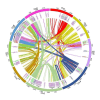The genome of Citrus australasica reveals disease resistance and other species specific genes
- PMID: 38594608
- PMCID: PMC11005238
- DOI: 10.1186/s12870-024-04988-8
The genome of Citrus australasica reveals disease resistance and other species specific genes
Abstract
Background: The finger lime (Citrus australasica), one of six Australian endemic citrus species shows a high natural phenotypic diversity and novel characteristics. The wide variation and unique horticultural features have made this lime an attractive candidate for domestication. Currently no haplotype resolved genome is available for this species. Here we present a high quality, haplotype-resolved reference genome for this species using PacBio HiFi and Hi-C sequencing.
Results: Hifiasm assembly and SALSA scaffolding resulted in a collapsed genome size of 344.2 Mb and 321.1 Mb and 323.2 Mb size for the two haplotypes. The nine pseudochromosomes of the collapsed genome had an N50 of 35.2 Mb, 99.1% genome assembly completeness and 98.9% gene annotation completeness (BUSCO). A total of 41,304 genes were predicted in the nuclear genome. Comparison with C. australis revealed that 13,661 genes in pseudochromosomes were unique in C. australasica. These were mainly involved in plant-pathogen interactions, stress response, cellular metabolic and developmental processes, and signal transduction. The two genomes showed a syntenic arrangement at the chromosome level with large structural rearrangements in some chromosomes. Genetic variation among five C. australasica cultivars was analysed. Genes related to defense, synthesis of volatile compounds and red/yellow coloration were identified in the genome. A major expansion of genes encoding thylakoid curvature proteins was found in the C. australasica genome.
Conclusions: The genome of C. australasica present in this study is of high quality and contiguity. This genome helps deepen our understanding of citrus evolution and reveals disease resistance and quality related genes with potential to accelerate the genetic improvement of citrus.
Keywords: C. australasica specific genes; Chromosome scale genome; Colour related genes; Disease resistance; Genetic improvement; Haplotype-resolved.
© 2024. The Author(s).
Conflict of interest statement
The authors declare no competing interests.
Figures




References
-
- Gmitter FG, Chen C, Rao MN, Soneji JR. Citrus fruits. In: Fruits and Nuts Edited by Kole C, vol. 4. Berlin: Springer; 2007: 265–279.
-
- Delort E, Jaquier A. Novel terpenyl esters from Australian finger lime (Citrus australasica) peel extract. Flavour Fragr J. 2009;24(3):123–32. doi: 10.1002/ffj.1922. - DOI
-
- Lim T. Citrus australasica. Edible medicinal and non-medicinal plants. Springer; 2012. pp. 625–8.
-
- Rennie S. Cultivation of Australian Finger Lime (Citrus australasica). In: Australian native plants: cultivation and uses in the health and food industries Taylor & Francis London; 2017: 81–87.
-
- Hawkeswood TJ. A review of some publications concerning Citrus (Microcitrus) Australasica F. Muell.(Rutaceae) in Australia and South-East Asia (mostly Thailand) Calodema. 2017;581:1–14.
MeSH terms
Substances
Grants and funding
LinkOut - more resources
Full Text Sources
Research Materials
Miscellaneous

